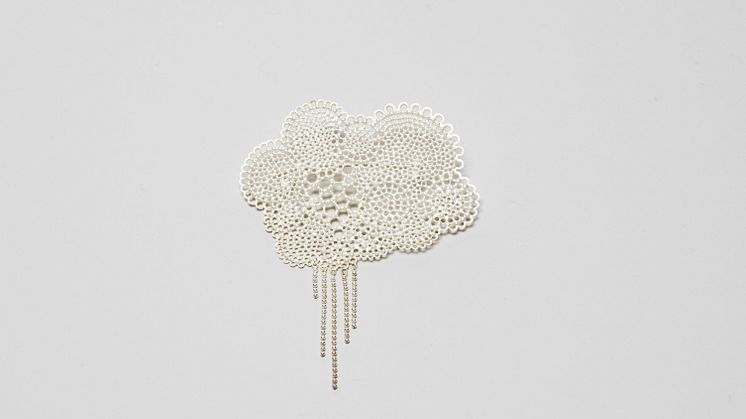
Press release -
Nationalmuseum acquires silverwork by Anna Atterling
Nationalmuseum has received 25 silver artefacts, forming 11 works, generously donated by the artist Anna Atterling. All the pieces were made using the silversmithing technique developed by Atterling, which results in delicate forms with decorative cavities. Several of the pieces will be on display in The Joy of Giving exhibition opening on 5 July.
Sometimes, artists develop their own mature aesthetic while they are still students, as was the case with Anna Atterling (born 1968). In her graduation exhibition at Konstfack in 2000, she unveiled a technique she had developed for working with silver plate, which resulted in delicate forms with cavities resembling a doily. Now, more than two decades later, Atterling has donated a number of her works to Nationalmuseum, having decided to take a break from silversmithing. The donation consists of jewellery and small sculptures: a total of 25 artefacts forming 11 works created between 2000 and 2012. There were already two works by Atterling in the museum’s collection: a brooch from 2005 and the crown In my Rose Garden from 2011, both donated by the Bengt Julin Fund.
Atterling describes how, in 1997, she visited Nationalmuseum’s exhibition of works by the Russian goldsmith Carl Fabergé (1846–1920). His richly ornamented eggs in precious metals and gemstones made a big impression on her, inspiring her graduation project. This project presented visitors with a wall of alternating hemispherical and flat silver sculptures, resembling a starry sky and creating a universe of its own. Atterling refers to these works as “pralines”.
The technique is laborious and time-consuming. Atterling starts with a thin sheet of silver plate, 0.2–0.3 mm thick. If she is creating a spherical or bowl-like object, she first crafts the form, on which she draws a pattern of circles. She then punches the sheet metal from both sides with a chasing hammer, transforming the circles she has drawn into elevations and depressions. When an elevation is formed, the shape and size of the neighbouring elevations changes. The metal becomes animated and alive. Throughout the process, Atterling listens to the material. Her eye and touch guide every stroke. Once she is satisfied, she files away the elevations on both sides of the silver plate to create decorative cavities. The silver is then blanched or oxidised. The resulting aesthetic is poetic and idiosyncratic.
Three of the pieces donated by Atterling are crowns, which appeared in her 2011 exhibition Wear Life like a Crown at Nutida Svenskt Silver (Contemporary Swedish Silver). The crowns can be worn for special occasions such as weddings or used as table decorations. However, Atterling wished the crowns could be worn in daily life too, since a crown on the head changes the wearer’s body image.
Cilla Robach, head of the collections department at Nationalmuseum, said:
“In her art, Anna Atterling tries to capture the fragile. The silver is hard and stable, but by perforating it she makes other aspects visible. Beauty, of course, but also the surface quality and the metal's ability to let light through.”
Several of the pieces will be on display in the exhibition The Joy of Giving – donated silver, which opens on 5 July.
Nationalmuseum receives no state funds with which to acquire design, applied art and artwork; instead the collections are enriched through donations and gifts from private foundations and trusts. This acquisition was generously donated by the artist, Anna Atterling.
Inventory numbers
Anna Atterling: Pralines, 2000. Sterling silver, blanched or oxidised. NMK 208 a–m/2022.
Anna Atterling: Bowl, 2002. Sterling silver, blanched. NMK 209/2022.
Anna Atterling: Bowl, 2003. Sterling silver, blanched. NMK 210/2022.
Anna Atterling: Bowl, 2003. Sterling silver, blanched. NMK 211/2022.
Anna Atterling: Pralines on foot, 2005. Sterling silver, blanched. NMK 212a-c/2022.
Anna Atterling: Necklace, 2006. Sterling silver, blanched. NMK 213/2022.
Anna Atterling: Necklace, 2008. Sterling silver, oxidised. NMK 214/2022.
Anna Atterling: Crown The Beaker, 2011. Sterling silver, blanched. NMK 215/2022.
Anna Atterling: Crown, 2011. Sterling silver, blanched. NMK 216/2022.
Anna Atterling: Crown, 2011. Sterling silver, blanched. NMK 217/2022.
Anna Atterling: Brooch Rain from the Sky, no. 8, 2012. Sterling silver, blanched. NMK 218/2022.
Media contacts
Cilla Robach, head of collections department, cilla.robach@nationalmuseum.se, +46 70 779 4908
Hanna Tottmar, head of press, press@nationalmuseum.se, +46 8 5195 4400
Categories
Nationalmuseum is Sweden’s museum of art and design. The collections comprise some 700 000 objects, including paintings, sculpture, drawings and graphic art from the 16th century up to the beginning of the 20th century and the collection of applied art and design up to the present day. Nationalmuseum is a government authority with a mandate to preserve cultural heritage and promote art, interest in art and knowledge of art.

